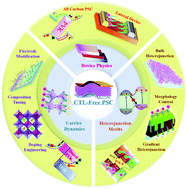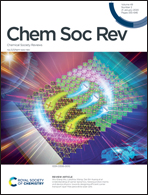Understanding of carrier dynamics, heterojunction merits and device physics: towards designing efficient carrier transport layer-free perovskite solar cells
Abstract
The power conversion efficiencies (PCEs) of perovskite solar cells (PSCs) are already higher than those of other thin-film photovoltaic technologies, but the high-efficiency cells are based on complicated device architectures with multiple layers of coating. A promising strategy to commercialize this emerging technology is to simplify the device structure while simultaneously maintaining high-efficiency. Charge transport layers (CTLs) are generally indispensable for achieving high-performance PSCs, but the high cost and possibility of instability hinder the mass production of efficient, stable PSCs in a cost-effective manner. The ambipolar carrier transfer characteristic of perovskite materials makes it possible to fabricate efficient PSCs even in the absence of electron and/or hole transport layers. Encouragingly, the reported PCEs of CTL-free PSCs are already over 20%. However, it is still a mystery about why and how CTL-free devices can work efficiently. Here, we summarize the recent strategies developed to improve the performance of CTL-free PSCs, aiming at strengthening the comprehensive understanding of the fundamental carrier dynamics, heterojunction merits and device physics behind these mysteriously simple yet efficient devices. This review sheds light on identifying the limiting and determining factors in achieving high-efficiency CTL-free devices, and proposes some empirical charge transport models (e.g. p-type doping of perovskites for HTL-free PSCs, n-type doping of perovskites for ETL-free PSCs, constructing efficient p–n heterojunctions and/or homojunctions at one side/interface or employing perovskite single crystal-based lateral geometry for both HTL and ETL-free PSCs, etc.) that are useful to further improve device performance. In addition, an insightful perspective for the future design and commercial development of large-scale, efficient and stable optoelectronic devices by employing carbon electrodes is provided.



 Please wait while we load your content...
Please wait while we load your content...